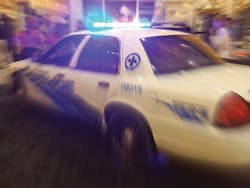We’ve all been there - a citizen calls 9-1-1 and reports hearing gunshots. We rush to the vicinity, look around and find nothing. A bonafide call? Maybe, but it’s difficult to determine because there may have been a lag between the event and the call, and the offender(s) is now gone. Or perhaps the loud reports weren’t shots at all. They may have been fireworks or a vehicle backfire.
Gun violence is ubiquitous. It occurs everywhere, from small towns to sprawling cities. The police rarely catch a shooter in the act. More often than not, we arrive too late and have little, if any, evidence to proceed. Citizens aren’t much help. Research shows that on average, only 10-20% of all gunshot incidents are reported to 9-1-1.
Technology, in the form of a product known as ShotSpotter™, provides an immediate solution to the problem of locating gunshot incidents accurately and quickly. By installing a system of sensors throughout the city, or in known trouble spots, ShotSpotter (SS) is able to provide street location, latitude and longitude coordinates, number of rounds fired, and speed and direction of travel if the shooter(s) is moving either on foot or in a vehicle. Priceless data.
In Washington, D.C., a city known for its strict gun control laws, SS has captured 39,000 gunshots since 2006. That’s an extraordinary number of shots fired for a city that does not allow concealed carry permits or open carry. The area covered by the sensors is approximately 20 square miles. Surprisingly, the number of shots captured by the system outpaces the number of reported felony gun crimes by more than 2 to 1, and more than half of the incidents involved multiple gunshots.
However, according to a police official, SS allows the department to identify areas of high crime and gang activity, which allows for a more efficient deployment of personnel and resources.
SS was developed on the West Coast in the early 1990’s by a scientist named Robert Showen. He introduced his idea to police in Redwood City, California. They liked his concept and became the first police department to utilize this revolutionary product. Now, more than 70 other police agencies in the U.S. employ the system, as well as the Rio de Janeiro police.
In D.C., the SS is also married to closed-circuit cameras that capture shooting incidents as they occur and their aftermath. The locations of sensors and cameras remain confidential, for obvious reasons, and the combination of both tools provide great evidence.
In Milwaukee, SS covers a 3-square-mile area. In 2012, there were 77 shooting incidents between May 24 and 28. The following year, between May 23 and 27, there was a 30% reduction in detected gunfire. The decreased gun incidents are directly related to the prompt and accurate response of police to SS shot detection.
One Milwaukee officer recalled that on one occasion SS directed him to a specific address, and when he arrived the offender was still shooting. Other cops report that they get to the scene of gunfire so quickly that they swear they can smell gunpowder in the air.
In the wake of increased school shootings, SS is thought to be a part of the overall solution to ameliorate this horrible phenomenon. One SS system is being installed in the Oakland California School for the Arts. The school is the first one in the country to utilize SS technology. According to Bloomberg News, SS CEO Ralph Clark explained that sensors placed in hallways, classrooms, or the cafeteria will detect any gunshots and immediately notify police. Officers will be able to have the school’s floor plan appear on their computer screen, showing the exact location, type of gun, and direction the shooter(s) is moving. Teachers and staff are also notified, allowing them to employ immediate security measures. Obviously, being able to pinpoint a shooter’s location inside of a building gives the police more of an advantage over entering the building with little or no information about the shooter or his location.
Other places to considerer deploying the SS system: malls, universities, airports, and hotels. The list is limitless. When used in conjunction with surveillance cameras, the likelihood of capturing the shooter is very high. One other benefit—when people are aware that such a system is in place, and that the response will be quick, the SS acts as a deterrent to crime. That the system can be deployed both indoors and out makes it a valuable tool for law enforcement, and one that departments should consider.
Stay safe, Brothers and Sisters!
Links:

John Wills
John M. Wills is a former Chicago police officer and retired FBI agent. He is a freelance writer and award-winning author in a variety of genres, including novels, short stories and poetry. John also writes book reviews for the New York Journal of Books, and is a member of the National Book Critics Circle. His new book, The Year Without Christmas, is available now. Visit John at: www.johnmwills.com.



